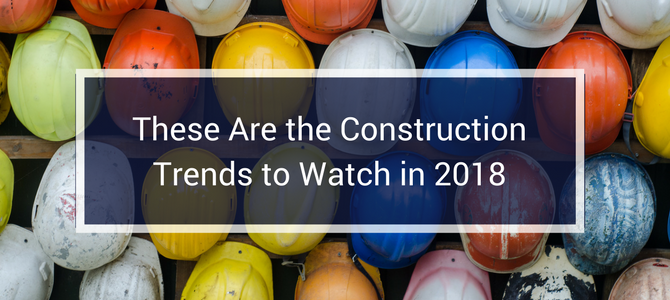These Are the Construction Trends to Watch in 2018
We’ve talked a lot about different trends for 2017 and even predictions for 2018. More specifically, we looked at the top safety violations in 2017, as well as website trends to keep in mind for 2018. But what is the construction industry going to look like in 2018?
Construction Dive weighed in with their predicted trends that we should all watch in the year ahead. Their full list includes 8 predictions, however we cover four of which we find the most important.
- Labor Shortage
This is an obvious one. As the industry has seen a shortage with employees in the past, this unfortunately isn’t going to suddenly change in 2018. Even though industry groups have been fighting for increased federal, state and local funding for trade school education programs, and companies have been making adjustments to make their work more efficient, the lack of skilled labor will continue to proceed throughout 2018. This means that now it is more essential than ever for dealerships to be more proactive about retaining current employees and attracting new ones.
- New Policy Regulation
Policies, such as the recent tax reform, may not be construction-centric, however it will have an important impact on businesses within the industry. For example, the public construction sector will benefit from private-activity bond financing and contractors structured as C-corporations and pass-through entities will benefit from tax relief. Additionally, this also trickles down to regulation within cities and states. For example, in New York City, Mayor Bill de Blasio signed a law that requires construction workers to have 40 hours of safety training.
Additionally, the Governor of California, Jerry Brown, signed a law requiring contractors acting as direct contractors on private construction projects to be financially responsible for any wages, fringe benefits and union contributions left unpaid by subcontractors and their subtiers.
Last, but not least, everyone is continuing to keep an eye out for that infrastructure bill, which could be released later this month and also have an enormous impact on inserting financing into the construction pipeline.
- Company Office Expansions
Some of the United States’ most notable companies, such as Google and Apple, expanded their high-tech campus facilities this past year. In the year ahead, we’re seeing the promise of widely discussed Amazon headquarters and potentially a redevelopment of Microsoft’s Redmond, WA, campus this year. While Amazon’s new headquarters is still to be determined, when they do announce their final decision it will be game changing for the location they pick and the construction companies and dealerships within the area. It’s also rumored that giants like Marriott and General Electric will be breaking ground with new headquarter developments relatively soon.
With these new facilities, also comes infrastructure needed to support the operations. For example, data center construction has taken off as these companies are obtaining higher amounts of information in their servers. As defined by Construction Dive, “Data centers are information warehouses that are able to host all or a portion of a company’s IT operations in one location. These warehouses use what can sometimes amount to thousands of servers amassing, storing and re-distributing information via the cloud or otherwise.”
- High-Tech Wearables and Drones
Technology has integrated into almost every area of our society, so it makes sense that it would infiltrate the construction industry as well. Smarter technology such as Microsoft’s HoloLens, which is a headset being used as smart protective eyewear for the industry, has begun to transform the way the industry works. Additionally, Triax’s Internet of Things-enabled sensors that help with jobsite connectivity and monitoring workers and equipment on the ground, has positively impacted the industry. Both of these technologies showcase the areas in which this kind of wearable technology will affect day-to-day work, which is safety and efficiency.
Drones will also play a large part in this, enabling contractors to better survey sites while also maintaining safety standards. This also saves the industry time and money by creating a quicker and more efficient way of surveying construction sites.
—
These are the four areas we see really progressing within the industry in 2018. What are some additional areas you see growth in for the year ahead? Feel free to leave your thoughts in the comments below or by emailing us at marketing@commercialwebservices.com.


